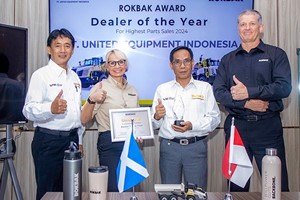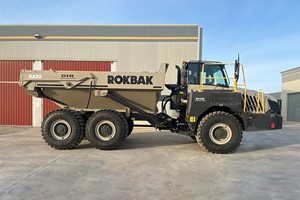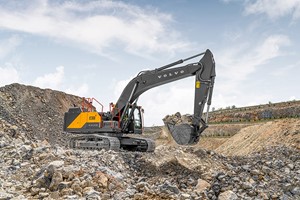The wheel tractor-scraper is a heavy-duty loading and hauling machine. It has been designed to suit tough working conditions. This tractor is a highly versatile piece of heavy machinery and is frequently relied on in the mining industry. Read on to learn more about how the wheel tractor-scraper works.
What Is the Wheel Tractor-Scraper Used For?
The wheel tractor-scraper can be used across a wide variety of applications. The machine can be used for:
- Mining coal, chalk, bauxite, and silicon sand
- Mine reclamation
- Mine-stripping applications
- Road development and construction
- Landfill cell construction
- Dam construction
These machines also work as selective tools for mining. This means the operator of the wheel tractor-scraper can choose specific areas within the mine and swiftly send the scraper fleet to work. In the appropriate conditions, such as when mining areas with moderate haul distances or a low percentage of rock, these heavy machines can be used to cut down on operating costs.
At the end of the day, if the load is under 10,000 feet and the material has rock that is 24 inches or less, a wheel tractor-scraper is an appropriate hauling system option.
How Is the Wheel Tractor-Scraper Designed?
The rear of this piece of heavy machinery has a vertically moveable hopper (also referred to as the bowl). It has a sharp horizontal front edge. The hopper can be hydraulically lowered or raised. When the hopper has been lowered, the front edge will cut into the earth surface and fill the hopper. Once the hopper has filled, it is then raised and closed with the vertical blade (commonly referred to as the apron).
What Materials Does the Wheel Tractor-Scraper Work With?
A wheel tractor-scraper can work with a range of materials. It can work with materials as fine as sand, all the way to rocks as large as 24 inches. Hence, this piece of heavy machinery works well in very tough conditions and material types. This contrasts with towed scrapers, which are more limited in terms of the materials they can work with.
How Long Do Wheel Tractor-Scrapers Last?
Some wheel tractor-scrapers have been designed to live multiple lives through machine re-builds. While a typical towed scraper system that works with materials containing no rock or materials with a density of less than 3,000 pounds will need to be replaced after 5,000 to 7,000 hours, a wheel tractor-scraper can last for an impressive 30,000+ hours without needing to be replaced. They are commonly considered a worthwhile investment for those working in mining and earthmoving.
John Deere Scraper
The Earthmoving Productivity System technology takes images from inside the scraper and displays them to the operator, all while calculating the yardage being loaded in real-time.
John Deere has launched its latest technological offering, the Earthmoving Productivity System, which is now available for scraper and earthmoving customers looking for a solution to enhance the measurement accuracy of volume loaded into a scraper in real-time. The Earthmoving Productivity System transfers critical data directly to the JDLink Dashboard, via JDLink Connectivity, enabling increased accuracy for job bidding and billing.
The Earthmoving Productivity System technology takes images from inside the scraper and displays them to the operator, all while calculating the yardage being loaded in real time. The calculated yardage is shown to the operator during every pass, added up after each cycle and is saved to show daily productivity. This system’s visual display also allows operators to view products being loaded into the scraper even when the view may otherwise be obstructed, enabling operators to maintain focus on what is in front of them.
“Customers in site development can now further manage their cost per yard and especially benefit by maximizing trip capacity and preventing spillage,” said Justin Steger, solutions marketing manager, John Deere. “This technology can be a game changer for customers completing scraping and earthmoving projects, and once integrated on the job, will become a critical system for operators.”
The Earthmoving Productivity System’s integrated solutions provide advanced data on the machine, such as total fuel burn and wheel slip. The system’s 3D camera provides video feed directly inside the scraper pan, enhancing operator visibility to the material loaded into the scraper. Available through an in-cab monitor, the operator can increase visibility to the inside of the scraper.
Available for installation on single, double, or triple scraper systems, the Earthmoving Productivity System can be retrofitted on all D-Series scrapers. This system is also compatible with select John Deere Scraper Special Tractors (2015 or newer), including the 9R, 9RT and 9RX models.
Scraper Special Tractors
Our largest Scraper Special tractors ever deliver more power to handle our larger-capacity ejector scrapers and our efficient, economical carry-all scrapers. Available in rubber-tire and track configurations, all 10 of our Scraper Special tractors feature spacious and quiet cabs, heavy-duty frames, and 18-speed PowerShift™ transmissions. Move more material with faster cycle times and you’ll find these earthmoving machines a great investment if you make your living moving dirt.
Scrapers
Our fully integrated tractor-scraper systems move more dirt than self-propelled scrapers or competitive tractors and scrapers, at one-third the initial investment and half the labor. Exclusive AutoLoad automates scraper functions, making it push-button easy for even first-time operators to load like pros. Even inexperienced operators will deliver consistently full loads with fewer passes using automatic blade raise/lower. And now D C and D E scraper pans are backed for 12 months regardless of hours.











